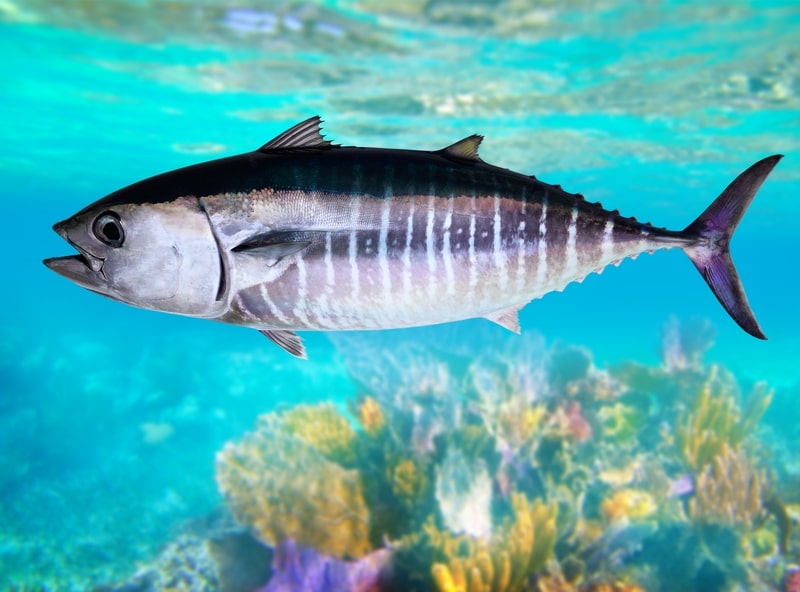
The blue fish is mostly found in oceans, weighs around 1500 pounds, and grows to a length of 6 to 10 feet. They are the biggest tunas and have a lifespan of around 40 years.
They are built like torpedoes and have retractable fins. They are strong predators from the moment they hatch, especially on fish like herring, eels, and even mackerel. Bluefish primarily hunt by sight since they have excellent eyesight for any bony fish.
People trying to catch the fish often ask, “How to rig a live bait for bluefin tuna?”.
If you are also trying to do this, then going through this article should help you in finding a small guide on how you can catch the fish while avoiding issues.
How To Rig Live Bait For Bluefin Tuna?
Worms or smaller fish that may be handled easily are often used as live bait. The only thing you need to do is utilize the fish as bait by tying it to your hook while it’s still alive.
Although it seems straightforward, there might be a number of issues when using this method to bigger species, such as bluefin tuna. You must thus carefully adhere to the instructions listed below.
The first thing you must do is choose a spot for your fishing trip. This often relies on the areas in which you reside, since locating a location close to you may be preferable.
However, the Mediterranean Sea and other places like it often have bigger bluefin tuna cruising near them. They are thus a fantastic place to go if you want to capture a big fish.
Plan your journey after you have a destination in mind. Additionally, the time of day when you will be fishing might be crucial.
The weather also has a significant impact since it may cause fish to go deeper into the ocean, making it more difficult to capture them.
You can now start deciding the bait you will be using to catch the bluefin tuna. There are several options that you can go for, but larger fish are usually the best options when it comes to catching this variety.
The only issue with this is that handling the live bait can also be a lot trickier. A general rule of thumb is using a larger hook for larger bait.
Finally, when it comes to putting up your live bait on the hook, make sure that you insert the hook at the side of the gills which are on the top part of your bait.
This allows people to have better control over their live bait while ensuring that it does not bleed to death before attracting any nearby bluefin tuna.
Proceed to move around a little until you notice a bite. You can then pull your line and hopefully catch a nice big bluefin tuna.
Hopefully, you’ll have a good idea on how to use live bait and catch more fish while sticking to the same budget. Yes, going with the live bait and limiting its movement to create a more natural presence in water can be hard.
However, if you’re experienced enough and use the right hook and technique, then live bait is the most viable option in the market.
You will not have to struggle with the line movement or the response from the bait as much if you follow the proper hooking technique.
Ideally, it will not take you a long period to get comfortable and experienced with hooking live bait for Bluefin Tuna.
However, if you’re new to the game, we suggest that you spend some time with an expert. Try relying on locals to help you get through the problem quickly and effectively.
Hopefully, you will not have to hassle as much with this setup, and managing the Bluefin Tuna will be simple for you.
Just be sure to get guidance, and that will put you far ahead on the learning curve. That way, you will not have to worry about wasting time.
Bridling Bigger Baits For Bluefin Tuna
Bridling is another robust technique when it comes to rigging live bait for Bluefin Tuna.
This technique might only look simple when you’re looking at the final presentation, but developing a perfect bridling system yourself can be more than just a little challenging.
So, if you’re also interested in this method, here are a few steps to help you figure out the setup.
It is essential to hold the live bait before using a rigging needle to make a tiny hole close to the eye socket. It will be built upon this to attach the hook to the bait.
The hook may then be safely secured by first making a loop with the floss. Make sure the floss doesn’t run out as it passes through the fish.
The floss can fit through the hole since it is broader now. The link between the hook and the bait will be created at this point.
To begin twisting the floss, just thread the rubber band through this hole and attach it to the hook.
This will pull the fish closer and tighter to develop a strong grip. You have to keep twisting until you see a bit of blood come out of the fish and there is no space between the floss and the bait.
At this point, you can pass the hook one more time below the floss and through the fish head one more time. The floss will now be fully secure and won’t unwind as you cast the bait.
Now, you just gotta get to fishing and cast the bait on open waters. Hopefully, you won’t have to deal with as much hassle and fishing for Bluefin will be easier for you.
These were the steps that you need to keep in mind when rigging up live bait for Bluefin Tuna.
The benefits of these methods are beyond effective, and you will be able to limit the interferences. Many anglers mentioned phenomenal fishing results after the bridling technique.
Sounds amazing right? Well, not quite. These results were only valid for anglers that were experienced and were able to handle all of these steps on the wet deck.
You will have to spend hours working on this technique to perfect it and there are no quick methods.
So, instead of thinking that everything will be sorted out with the bridling technique, you should focus more on how you can perfect the technique first. The best method that you can rely on is to get help from the local anglers.
You gotta find an angler that is a bit experienced and know how to handle live bait in rough conditions. That way, you will be able to get a practical demonstration along with many pointers on how to get a good response from the bait.
Moreover, you will learn how to manage the line control and the bait movement to attract more fish. The right hooking technique will only take you so far and you’re bound to run into issues when the line control is not optimal.
Wrapping Up
We’ve listed some pointers on how to rig live bait for Bluefin Tuna. you can either rely on a large hook and pierce that through the eye socket or rely on the bridling technique.
Both of these methods are valid, with the bridling technique being better for most experts.
Therefore, just continue applying and honing this method to improve your fishing experience.
To produce a realistic presence in the water, you must also regulate the movement of the line and rod in addition to the rigging procedure.
You can’t acquire any hooks if the bait is irregular or not moving at all. Therefore, all you are actually attempting to do is move the bait about in the water in an effort to draw in the bigger Bluefin Tuna without endangering it.
It will be difficult at first, but when you’re getting help from local experts, your job will be much easier.
For this reason, we will always suggest that you get help from the locals and don’t try to fix everything on your own. Otherwise, you’ll just be overcomplicating the situation.



